
A GROWING number of areas in England are seeing a rise in Covid-19 case rates - but the North-East continues to fall.
Seven days ago, just 21 out of a total of 315 local authority areas had recorded a week-on-week jump in rates. That figure now stands at 126.
While a majority of places are still recording a fall, the North-East is the only region where are rates coming down in all local areas.
READ MORE: Covid: These places in North-East and North Yorkshire have fewer than three cases
The latest figures also suggest that the places where case rates are rising are no longer concentrated in just a few pockets of England.
Here is a region-by-region guide to all the latest figures, including the areas recording the biggest week-on-week rise and fall.
In all instances, the rates are for the week ending December 3 and have been calculated by the PA news agency using data published by Public Health England.
READ MORE: If you have one of these 202 North-East surnames you could inherit a fortune
North-East
This is the only region in England entirely in Tier 3 of the Government’s Covid-19 restrictions.
It is also the only region where rates are dropping in all local areas.
The area seeing the biggest week-on-week fall is North Tyneside, down sharply from 235.2 cases per 100,000 people to 152.0.
Hartlepool currently has the highest rate in the region: 234.9, down from 268.0.
Gateshead has the lowest: 106.4, down from 187.1.
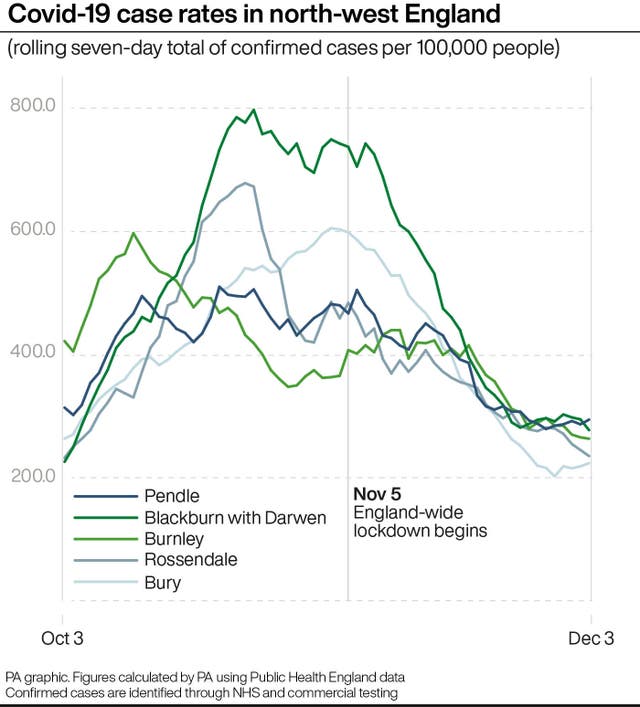 (PA graphic)
(PA graphic)
North West England
Most of north-west England is in Tier 3, with some notable exceptions: the six local authorities within the Liverpool City Region; Warrington; Cheshire East; Cheshire West & Chester; and all the local authorities in the county of Cumbria. All of these are in Tier 2.
Just five areas in the region are currently recording a rise in rates: Barrow-in-Furness (Tier 2), Cheshire West & Chester (Tier 2), Pendle (Tier 3), South Lakeland (Tier 2) and West Lancashire (Tier 3).
But in each area, the increase is very small.
West Lancashire has seen the biggest jump in the region, but here the rate is up only slightly from 113.7 to 124.2.
Pendle has the highest rate in the north-west: 294.2, a tiny rise from 293.1.
By contrast, Oldham has seen the steepest week-on-week drop, from 272.9 to 160.3.
The area with the lowest rate in north-west England is Copeland, with 41.1.
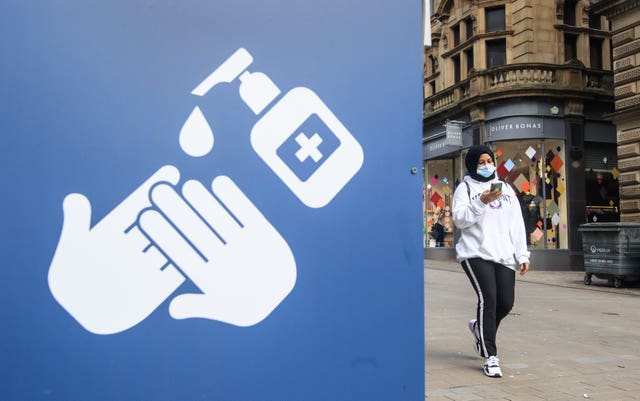 Advice on offer in Leeds (Danny Lawson/PA)
Advice on offer in Leeds (Danny Lawson/PA)
Yorkshire and the Humber
Almost the whole of this region is currently in Tier 3, save for the city of York and the county of North Yorkshire, which are in Tier 2.
Rates are down across the region except in three local areas: Craven, Doncaster and Scarborough.
In each case the week-on-week increase is very small, however.
Craven, which has seen the biggest jump, is up from 122.5 to 138.3.
Doncaster has the highest rate in the region: 214.5.
York has the lowest: 60.3.
Today kicks off the biggest vaccination programme in the history of the NHS.
A huge thank you to everyone who has worked tirelessly to make the #COVID19 vaccine happen.
Click on the graphic below to see who will be offered the #vaccine first. pic.twitter.com/qrM5ZhWDAy
— Public Health England (@PHE_uk) December 8, 2020
West Midlands
Every area in the West Midlands is currently recording a fall in rates, except one: Staffordshire Moorlands, where the rate has crept up very slightly from 198.1 to 202.2.
The biggest week-on-week drop is in North Warwickshire, down from 251.3 to 118.0.
Herefordshire, Shropshire and Worcestershire are currently in Tier 2; the rest of the West Midlands is in Tier 3.
The highest rate in the region is for Stoke-on-Trent (348.7) and the lowest is for Stratford-on-Avon (47.7).
🇬🇧 The #COVID19 vaccination programme is starting in the UK today 🇬🇧
Health services in each nation are vaccinating with the #COVID19Vaccine.
If you are in a priority group eligible for vaccination, you will be contacted to book an appointment 📅https://t.co/PKVgX10aE3 pic.twitter.com/uW0PR4nJmW
— Department of Health and Social Care (@DHSCgovuk) December 8, 2020
East Midlands
Rates are down in 28 areas in the East Midlands and up in 12.
The biggest week-on-week drop in the region is in East Lindsey, down from 306.2 cases per 100,000 people to 196.9.
All of the East Midlands is currently in Tier 3, except for the county of Rutland and all local authority areas in Northamptonshire.
Rutland is one of three Tier 2 areas where rates have risen, along with Northampton and Wellingborough.
The other nine areas where rates have increased are all in Tier 3 – including South Kesteven, which has seen the biggest week-on-week jump in the region, up from 141.1 to 211.3.
Boston in Lincolnshire has the highest rate in the East Midlands, 443.2, while Derbyshire Dales has the lowest: 74.7.
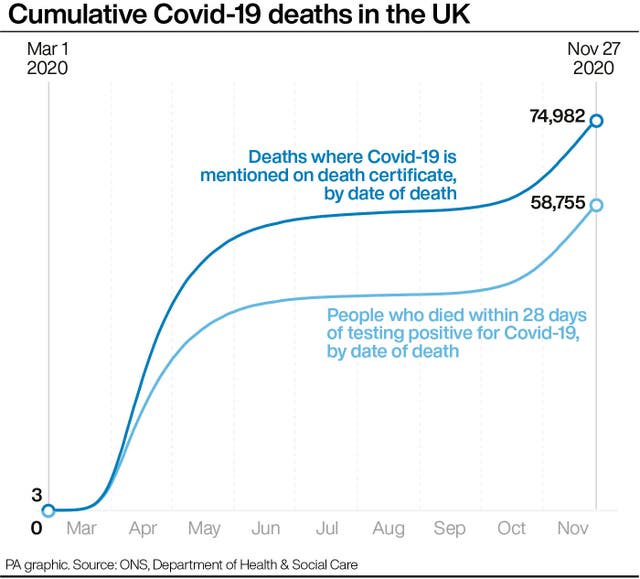 (PA Graphics)
(PA Graphics)
Eastern England
The whole of Eastern England is currently in Tier 2.
Rates are rising in most areas, however – 35 out of a total of 45 in the region.
Basildon has recorded the biggest jump, up from 290.6 to 390.5.
This is also the highest rate for any area in the region.
North Norfolk has seen the biggest week-on-week fall, down from 90.6 to 65.8.
Mid Suffolk currently has the lowest rate: 46.2, up from 37.5.
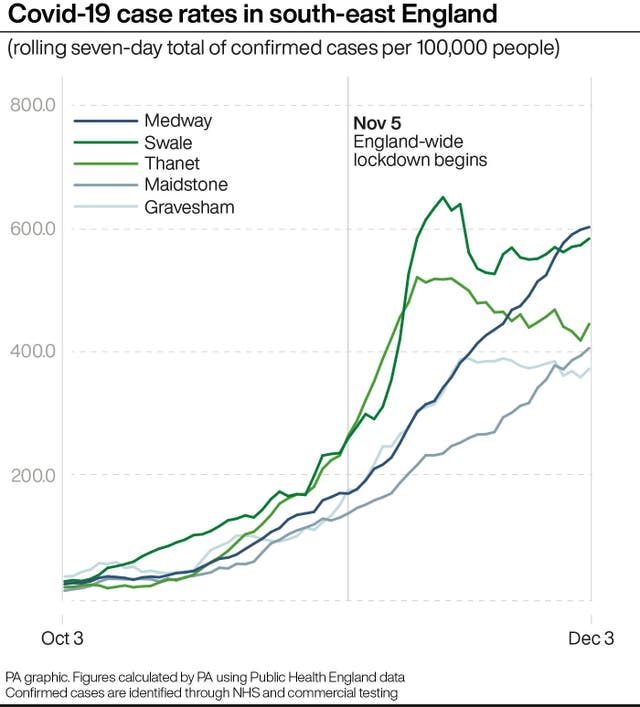 (PA graphic)
(PA graphic)
South-east England
Of the 67 areas in this region, 40 are recording a rise.
Runnymede – currently in Tier 2 – has seen the biggest week-on-week jump, up from 143.1 to 275.1.
Slough – currently in Tier 3 – has seen the biggest drop, from 298.2 down to 241.4.
Currently 14 areas in the south-east are in Tier 3, comprising the county of Kent plus Slough.
Everywhere else is in Tier 2, except the Isle of Wight which is in Tier 1.
South-east England is notable for containing both the highest and the lowest rates in the whole of England.
Medway has the highest, 607.1 (up from 495.4), while the Isle of Wight has the lowest, 19.8 (down from 31.0).
South-west England
Seven local authority areas in south-west England have recorded a rise in the latest figures, all of which are currently in Tier 2.
Everywhere else in the region is currently recording a drop in rates.
This includes the three areas of the south-west that are in Tier 3: Bristol, North Somerset and South Gloucestershire.
North Somerset has seen the biggest drop of anywhere in the region, down from 178.1 to 117.6.
South-west England includes the only other area in England, along with the Isle of Wight, that is in Tier 1: Cornwall & the Isles of Scilly.
Here the rate currently stands at 25.5, down from 33.9, and is the lowest in the region.
West Devon, in Tier 2, has seen the biggest week-on-week increase, though it’s only a small rise: up from 59.1 to 87.8.
Gloucester has the highest rate in the south-west: 158.0.
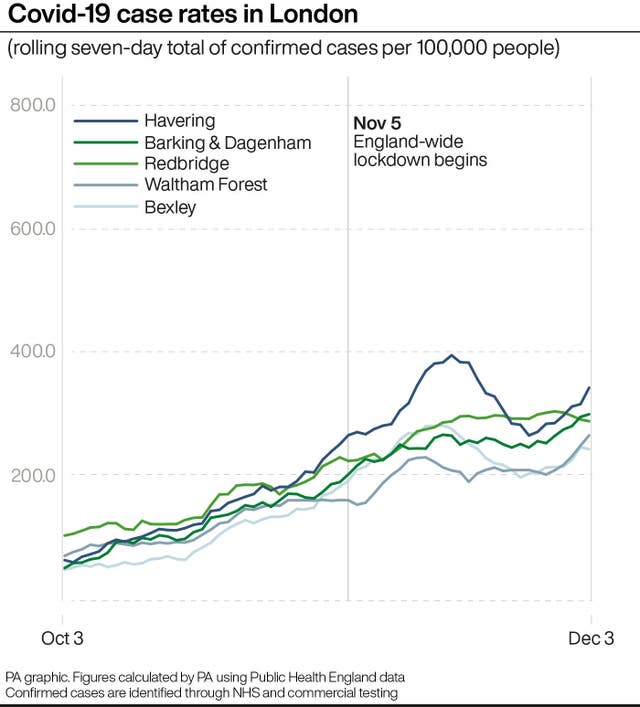 (PA graphic)
(PA graphic)
London
London is another region that is entirely in Tier 2.
Rates are up in 23 of 32 areas across the capital.
The biggest jump is in Havering, where the rate has increased from 268.5 to 346.0 – the highest rate anywhere in London.
Hounslow has recorded the biggest drop, down from 170.2 to 147.3.
Richmond-upon-Thames has the lowest rate in the capital: 80.3.



Comments: Our rules
We want our comments to be a lively and valuable part of our community - a place where readers can debate and engage with the most important local issues. The ability to comment on our stories is a privilege, not a right, however, and that privilege may be withdrawn if it is abused or misused.
Please report any comments that break our rules.
Read the rules here